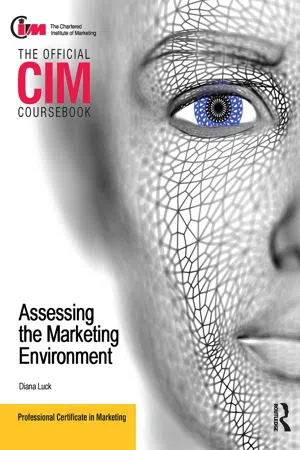Marketing
Marketing Information System
A Marketing Information System (MIS) is a structured approach to gathering, analyzing, and managing information relevant to marketing decision-making. It involves collecting data from various sources, processing and interpreting it, and then disseminating the resulting insights to support marketing strategies and tactics. MIS helps organizations stay informed about market trends, customer preferences, and competitive activities to make informed business decisions.
Written by Perlego with AI-assistance
7 Key excerpts on "Marketing Information System"
Learn about this page
Index pages curate the most relevant extracts from our library of academic textbooks. They’ve been created using an in-house natural language model (NLM), each adding context and meaning to key research topics.
- Ray Donnelly, Colin Linton, Colin Linton(Authors)
- 2010(Publication Date)
- Routledge(Publisher)
2003 ).Historically organisations may have collected large amounts of data on their customers. However, it was not necessarily in an accessible format, or in some cases, it just wasn’t made available to the right people and opportunities to increase sales were missed, or the opportunity to build closer relations with customers lost, hence competitive advantage was lost or reduced.Now most organisations are investing in a Marketing Information System (MIS) to improve data management.A Marketing Information System (MIS) consists of people, equipment, and procedures to gather, sort, analyse, evaluate and distribute needed, timely and accurate information. (Kotler, 2003 )An MIS stores and disseminates information within an organisation. In essence a MIS is a framework which allows for information to be collected from a variety of sources, both internal and external to the organisation. This information is then combined with other relevant information to produce a specific range of reports that helps the organisation manage its marketing more effectively.Large organisations generate vast amounts of information and to be effective the MIS must be specific to the organisation. What data should be collected? How should it be collected? When and who should it be made available to?Consider the following statement made by the Sales Director: ‘Sales have increased 10% in the past six months’. Before we can make a judgement on importance of the statement the sale directors adds some additional information: ‘Competitors’ sales have increased 12% in the last six months’Figure 15.1The initial statement doesn’t look as impressive now. The point is that an MIS needs to provide individuals with the information they need to care out their role effectively. Of course MIS relies on many non-marketing systems.- eBook - ePub
International Strategic Marketing
A European Perspective
- J.B. McCall, Marilyn Stone(Authors)
- 2004(Publication Date)
- Routledge(Publisher)
et al., 1999: 317).Internal staff within the marketing services function, usually located at, or within close proximity to, the organization’s central head office, are expected to manage the MIS. The marketing data is gathered through a combination of formal and informal communication routes using internal and external sources within the organization. It can come from any, or all, of the accounting and finance, research and development, production and personnel functional areas. Formal internal sources of information include sales force reports and sales monitoring, while informal sources could be data gathered through meetings with colleagues and associates. Formal external information comes from a wide range of sources including statistics produced by international bodies such as the United Nations (UN), the World Health Organization (WHO) and the World Bank, national governments and trade associations. More informal external sources of data might be trade experts attending trade exhibitions and seminars, as well as industry experts working within marketing research agencies, advertising agencies and management consultancies.An MIS is developed from the inter-linkage and analysis of data collected from three types of information gathering (see Figure 4.1 ). These are internal reporting, marketing intelligence and marketing research.The three data gathering sources should interact on a continuous basis, e.g. internal reporting sources covering information obtained from within the organization may be used in the preparation of marketing research studies. Similarly, marketing intelligence environmental scanning is used in conjunction with the internal reporting process which, in turn, can feed into the marketing research function. All the data gathered from the internal reporting process, from marketing intelligence and from marketing research should be analysed and assessed to determine market trends. These are used to develop databases for the organization providing market data related to actual and potential customers which, in turn, help management to monitor market activity and ascertain the organization’s performance. In this way, a list of customers might detail customer locations, their purchasing patterns and the payment methods that they use and this can help the marketing department to decide on the most appropriate marketing mix to reach the customer. Product characteristics, pricing strategies, promotional approaches, advertising and the sales effort, as well as the appropriate logistics operations, can be determined in conjunction with segmentation, positioning and targeting strategies. - Callie Daum, Vibrant Publishers(Authors)
- 2020(Publication Date)
- Vibrant Publishers(Publisher)
Research in Marketing
In order to carry out all of the work described in the previous sections, research must be completed to gather all of the information needed. This information is referred to as market research. In the next sections we will discuss how to pull together the information and interpret it.Information Systems
Information systems exist for almost every business function. The same is true for marketing. A Marketing Information System (MIS) uses people, equipment, and procedures to pull together, organize, review, interpret, and disseminate marketing information to the appropriate decision makers. Marketing managers are the operators, in a sense, of the MIS. First, the marketing manager works with the MIS to determine the marketing question(s)that needs an answer. Next, the MIS pulls from various information sources to construct the needed information for the marketing manager. Lastly, the MIS distributes the gathered information to the manager to help answer the posed question(s), so they can plan, implement, and control operations moving forward. The marketing manager walks hand in hand with the MIS throughout the entire process.Constructing Information
Information is constructed from various resources. These resources can be classified into three different categories including internal records, marketing intelligence, and marketing research. The information system pulls this information and packages it together to ensure that the information is presented in the correct context, is appropriate, and applicable to the marketing question at hand.If we examine further, we can describe internal records asinformation that is gathered internally from the organization to help identify strengths and weakness, issues and opportunities, and overall performance. This information could include things such as financial statements, sales records, reporting on manufacturing efficiencies and capabilities, and customer service feedback and issues. Utilizing internal records is a quick function and is low cost as compared to trying to pull information from outside sources. The downside is that the information can often be incomplete or not in a context or format that is useful for marketing purposes. An even larger problem is the sheer amounts of data and information a company can generate. The effort of combing through this information for the right data can be time consuming and difficult to find or track.- eBook - ePub
Small Enterprises and Entrepreneurship Development
Empirical Evidence, Policy Evaluation and Best Practices
- Enyinna Chuta, Enyinna Chuta(Authors)
- 2012(Publication Date)
- Amalion(Publisher)
CHAPTER 15Marketing Information SystemS FOR SMALL ENTERPRISES
JOSEPH MAMMAN IBBIH
The Concept
Marketing Information Systems or strategies (MIS), otherwise called marketing research, include a set of techniques for obtaining information about the environment of an enterprise and its products and for forecasting future trends (Ibbih 2003). This is done so that the product or the enterprise may respond efficiently to change and to the needs of the environment.Before venturing into any business, it is essential to have a good grasp of the size of the market for the products and services of the enterprise. A business idea should be pursued further only if the anticipated volume or demand, both locally and for export, can be assured, with certainty, to be above a certain minimum level.The concept of a market includes the entire environment in which the enterprises are to operate and all kinds of technical, material, political, legal and administrative restrictions. A product or service cannot be sold or an enterprise cannot operate unless it has been created for a specific market. Thus, the success of an enterprise depends largely on its success in the marketplace. Therefore, the initial consideration of any potential entrepreneur is to properly assess the marketability of the business idea. How well entrepreneurs handle the opportunities that come their way and how they provide solutions to current and reoccurring market problems depends on how well their MIS is strategically managed.Kotler (1984) describes MIS as an integrative whole system that is made up of other sub-systems, that is to say a marketing environment and the market information. Smith et al (1968) see MIS as a continuous and interacting structure comprised people, equipment and procedures used in gathering, sorting, analyzing and distributing timely and accurate information in relation to planning, implementation and control. - eBook - ePub
- Geoffrey Lancaster, Lester Massingham(Authors)
- 2017(Publication Date)
- Routledge(Publisher)
DSS) were developed in the late 1970s and are designed from the viewpoint of an individual decision-maker. They are computer-based systems that are interactive and flexible, so results can be generated on the spot and then sorted and regrouped and manipulated as required. Managers can probe for trends and isolate problems.The MkIS is an invaluable aid to decision-making and is a specialized subset of the corporate management information system (MIS). The term ‘management information system’, along with that of MkIS, is synonymous with data processing and forms a framework for managing information that is gathered from both outside and inside the organization. The MIS consists of five separate planning subsystems, namely: Production or Operations; Human Resource Development; Finance; Logistics; and, of course, Marketing, which itself consists of four subsystems, as shown in Figure 13.1 .1 The internal accounting system is a system that reports orders, sales, dispatches, inventory levels and cheques receivable and payable.2 The market intelligence system is a set of procedures and sources used to obtain everyday information about pertinent developments in the marketing environment, largely built up from data such as reports from sales representatives.3 The marketing research system is the systematic design, collection, analysis and reporting of data findings relevant to a specific marketing situation facing the company.4 The analytical marketing system analyses marketing data using statistical procedures and models. This analysis feeds into strategic marketing plans.Subsystems 1, 2 and 3 are data collection methods, whereas subsystem 4 is an analytical method. Together they provide a framework for marketing managers to marshal their thoughts into tactics and to assist management in seeing the important elements of a particular situation and examining the relationships between these elements. A successful MkIS provides a structure for the analysis, planning and control of a given set of activities. Creating an MIS and MkIS for any business is a complex, individualized process. - Nigel F. Piercy, Nigel F. Piercy(Authors)
- 2018(Publication Date)
- Routledge(Publisher)
By definition, NIT increases the amount of information available. Therefore, as well as changing the inherent strategy adopted by the organisation, a management information system (MIS) is required to handle the extra information created. Hand-in-hand with this MIS development is that of a Marketing Information System (MKIS), which deals specifically with marketing strategy and operations.In real terms, the MKIS is the MIS, or indeed the decision support system (DSS), which relates to marketing activities and marketing information. A more formal definition is supplied by Buzzell et al (1969) as,A set of procedures and methods for the regular, planned analysis and presentation of information for use in making marketing decisions. Various writers have analysed this phenomenon (Uhl, 1974; Graf, 1979) and in summary they have shown how the MKIS can be used for:– data storage and retrieval, simplifying the accessibility of information;– monitoring systems, checking progress and variations in, for example, sales or market share data.– analytical information systems – a facility for options as to the results of various competitive actions e.g. price cuts, merchandising policies, etc.All this provides an in-depth crisis information system along with current-awareness and incidental-information systems.Formal recognition of MKIS is needed because of the increasing information derived from NIT adoption. The basic research information collected in this way can be used to develop cause and effect models of responses to marketing actions. It follows that, as NIT increases and suggests new marketing approaches, an efficient MKIS is essential for efficient information management.However, this is the ideal. In reality, Piercy (1981) has shown how such attention to system creation is sadly lacking in many companies.MKIS development tends to be hampered by the ability of managers to process the information produced by computer systems and to cope with NIT itself. Indeed, the question is raised whether such management is able to choose the actual information sources so as to compile the MKIS in the first place.- Diana Luck(Author)
- 2010(Publication Date)
- Routledge(Publisher)
Make time to apply all of the techniques discussed in this section to ‘fix’ each one in your mind. Use them to analyse your organisation or college. This activity will help you remember the associated methods.THE ANSOFF MATRIX
– This is a strategic tool used to aid the strategic thrust, which defines the future direction of the business.– Four generic alternatives/business options are offered:Market penetration: existing market/existing productProduct development: existing market/new productMarket development: new market/existing productEntry into new market: new market/new product– The rigid and rational approach can be limiting– Time is also not considered.Marketing Information System (MkIS)
A Marketing Information System can be used by organisations for a variety of reasons:– To generate new knowledge or access it from external sources.– To represent knowledge in documents, databases, software, promotions and so on.– To embed knowledge in new processes, products and services.– To diffuse existing marketing information throughout an organisation.– To apply accessible knowledge to effective marketing decision-making.– To facilitate more knowledge through market research and competitor intelligence.– To measure the value of marketing knowledge assets and their impact.– To identify opportunities and/or create value.Market research can provide some important specific feedback, but a marketing intelligence gathering system is the main means of identifying emerging trends.– A balance has to be struck between the benefits of additional information and the costs of collection and of inaccuracy arising from insufficient data.THE CONTINUING IMPACT OF NEW INFORMATION COMMUNICATION TECHNOLOGY (ICT)
Information technology and communication advances are increasingly converging. This has several implications for the marketing environment:






